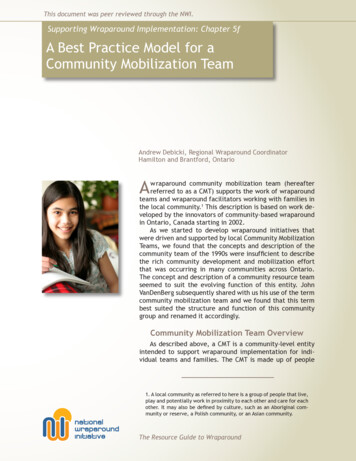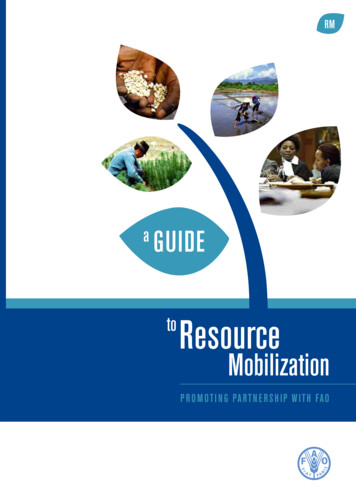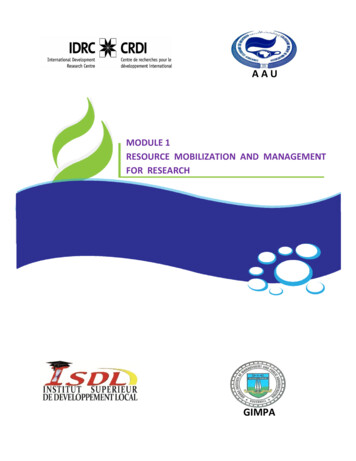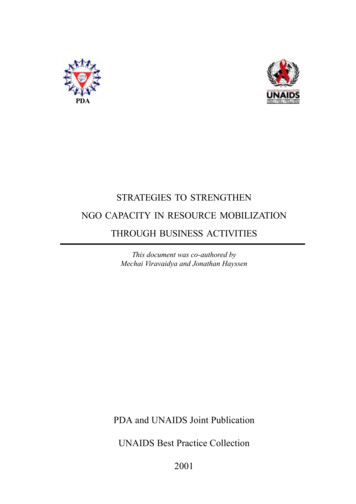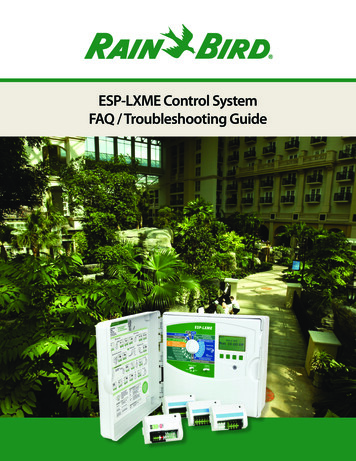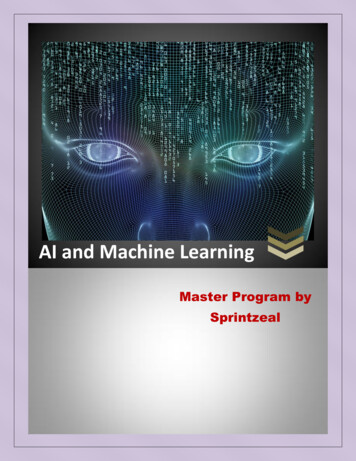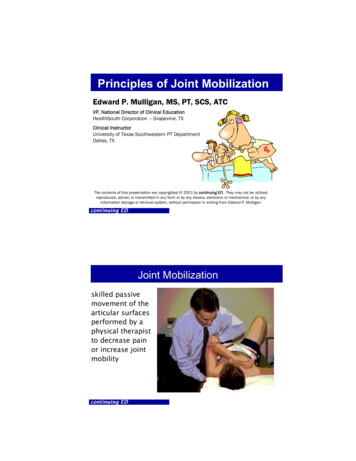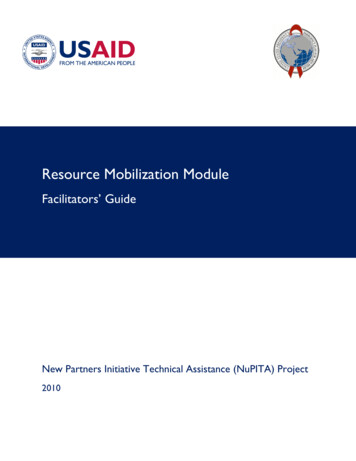
Transcription
Resource Mobilization ModuleFacilitators’ GuideNew Partners Initiative Technical Assistance (NuPITA) Project2010
The New Partners Initiative Technical Assistance (NuPITA) project is funded by the United States Agencyfor International Development (USAID) and implemented by John Snow, Inc. and Initiatives Inc., contractGHS-I-00-07-00002-00.This document is made possible by the generous support of the American people through USAID. Thecontents are the responsibility of John Snow, Inc. and do not necessarily reflect the views of USAID orthe United States Government. 2010 John Snow, Inc.NuPITAJohn Snow, Inc.44 Farnsworth StreetBoston, MA 02210-1211Phone: 617.482.9485www.jsi.com
ContentsPre-workshop Questionnaire. 1Introduction . 5Session 1: Developing the Road Map. 7Agenda . 8Donor Grid . 16Criteria for Donor Assessment . 20Internet Research Sites . 21Donor Screen Shots . 23Donor Expectations . 30Donor Cultivation Guidelines. 31Strategic Networking Guidelines . 32Session 2: Strengthening the Building Blocks . 33Agenda . 34Prime/Sub/Grantee Matrix . 41Positioning Your Organization with USAID . 42Preparing Your Organization to Act as a USAID Sub-contractor . 45USAID Documentation Checklist. 47Recent RFA Announcement Role Play . 49Proposal Components Checklist . 50Effective Corporate Capabilities Statements . 51Resource Mobilization Checklist . 55Resource Mobilization Systems Checklist . 56Session 3: Developing Effective Proposals . 58Agenda . 59Positioning Your Organization for an RFA . 65
Session 4: Putting it All Together: Resource Mobilization Plan Development. 66Agenda . 67Session Recap Questions . 70Table of Contents: . 72Resource Mobilization Plan. 72Resource Mobilization Action Plan Guidelines . 73Resource Mobilization Action Plan: Sample . 75Resource Mobilization Action Plan: Blank . 81Overall Evaluation (of Days 1-3). 83Daily Evaluation . 85
Pre-workshop QuestionnaireThe purpose of this pre-workshop questionnaire is to ensure that your facilitators have the informationthey need to tailor the resource mobilization workshop to the specific needs of your organization. Usinga series of tailored, hands-on, and interactive exercises, the goal is for participants to leave theworkshop with a clear action plan that can serve as a road map for achieving your resourcedevelopment goals.Your responses will be enormously helpful as we plan the upcoming workshop. All responses will bekept confidential. The survey should take about 30 minutes to complete.1. Does your organization have a strategic plan? If so, would you be willing to share it inadvance of the workshop, even if it is in draft?Have strategic plan:YesNoWilling to share document:YesNo2. Does your organization have a resource mobilization (development) plan? If so, wouldyou be willing to share it with us? Even if the plan is informal, this information would bevery useful.Have resource mobilization (development) plan:YesNoWilling to share document:YesNo3. Please name your organization’s top five donor prospects (e.g. USAID, DFID, GlobalFund, the Bill & Melinda Gates Foundation, etc.), and tell us why you are targeting thesedonors.1.2.3.4.5.1
4. What are the primary hurdles you face in securing funding from these donors?1.2.3.4.5.5. Who do you currently consider as part of your resource mobilization network? (Peoplein your organization, on your board, or within the network of relationships who canintroduce or link you to priority 9.10.10.6. Please list your top six donors, approximate funding levels, and annual budget.NameFunding levelAnnual budget1.1. 1.2.2. 2.2
3.3. 3.4.4. 4.5.5. 5.6.6.6.7. Please check the top 5 topics that will be of most value in helping you to achieve yourresource mobilization goals. Order from 1-5, with 1 as the top priority.Understanding the donor environmentDonor assessment criteriaUnderstanding donor characteristics and Internet research toolsDonor expectationsStrategic networking and marketingElements of a resource mobilization planRoles and responsibilities of prime, subs, and grantees for USG-funded projectsPositioning your organization for a proposal (RFA)Negotiating as a prime or subProposal componentsDeveloping effective corporate capabilities statementsResource mobilization systemsProposal developmentDeveloping a resource mobilization action plan8. Who in your organization is currently responsible for resource mobilization and whatare their key .5.Will all these people attend the planned RM consultancy? If not, who will not be able to attend?3
9. How is resource mobilization progress measured in your organization?10. What kinds of fundraising systems do you have in place to support your resourcemobilization activities? (please check all that apply)1. Clear staff and board roles and responsibilities for resource mobilization2. System for organizing, managing, and updating new donor contacts3. Updated templates for proposalsa. Budget and budget notesb. Updated CVsc. Corporate capabilities statement4. Supporting documentationa. Board list with affiliations/job titlesb. Tax exempt letterc. Latest financial statementd. Annual operating budgete. Latest audit letter/findingsf. Resumes for key staffg. Letter of supporth. Recent evaluationsi. Press clippingsj. Marketing materialsk. Central location to house above documents5. Resource mobilization plana. List of strategic prioritiesb. Articulated goals/objectivesc. List of donor prospect targetsd. List of people who can provide introductions to prospectse. List of priority networking events/meetings11. What are your three top goals for the resource mobilization workshop?1.2.3.12. What else should we know about your organization or the people who will be attendingthe resource mobilization workshop to make it as effective as possible?4
INTRODUCTIONWho is this manual for?This manual is designed to build the skills of facilitators and trainers working with a range oforganizations to develop practical resource mobilization plans. Organizations may include internationalnon-governmental organizations (INGOs); national NGOS; national and international faith-basedorganizations (FBOs); and, smaller, grassroots community-based organizations (CBOs) that provideservices to communities, families, and children who have been affected by HIV and AIDS.These materials can be used as a package or as separate sessions depending on the needs of theorganization; however, the goal is for all participants to leave the sessions with a draft resourcemobilization plan. The module consists of four sessions. Sessions 1 and 2 are 8 hours each; Sessions 3and 4 will take between 4-5 hours each. Organizations may choose to focus on specific topics asopposed to an entire session. Resource mobilization sessions are not designed as one-time workshopsbut as steps on a continuum that includes specific, follow-up technical support identified in the draftresource mobilization action plan. The resource mobilization action plan will help organizationsprioritize activities that are realistic, specific, measurable, achievable, and time-bound. This process willenable each organization to assess progress and make adjustments as they implement their plan.Resource mobilization module learning approachUsing small group interactive exercises, large group discussions, role plays, and examples fromorganizations, facilitators will draw upon participants’ own experience, knowledge, and ideas to helpthem identify the people, networks, tools, strategies, and systems they need to develop and implement asuccessful resource mobilization strategy. The modules build upon the NPI Resource DevelopmentTraining held in Washington, DC from June 16-18, 2010, and are designed to be flexible and responsiveto the specific needs of organizations across a continuum of development stages.The components of this module are designed to reinforce each other, and are participatory andpurposefully interactive to enable participants to grapple with the inherent challenges of organizingpriorities, assigning responsibilities, and uniting the organization and its board in common goals andobjectives. The exercises are also designed to reflect and reinforce the adult learning cycle.Best results can be expected from trainers and facilitators with knowledge and experience in: a) workingwith adult learners; b) mobilizing resources from a range of donors; c) building the capacity of a range oforganizations; and d) experiential and participatory learning techniques.5
Who should attend the workshops?Workshop participants should include: a) resource mobilization leadership teams; b) all organizationalstaff involved in resource mobilization, including finance staff; and c) board members involved inresource mobilization.Pre-workshop preparation for facilitators Send out pre-workshop questionnaire to organizational leadership at least two weeks before theworkshop. Meet with organizational leadership at least a week in advance to determine, in detail, the goals,expectations, staff attendance, and roles and responsibilities for facilitators and participants duringthe workshop. Ensure that all participants have hard and soft copies of the June 2010 “NPI Resource DevelopmentTraining” materials. Ensure that facilitators and participants have a clear understanding of why they are attending theworkshop. Send agendas and copies of all handouts in soft copy to all participants at least five days before theworkshop. Assemble hard copy packets including agendas, handouts, and evaluations for facilitators andparticipants to distribute on the day of the workshop. Ensure that all materials are compiled in advance — flipchart paper, flipchart stands, markers,masking tape, facilitator laptop, LCD projector and screen, PowerPoint presentations, and BLANKand SAMPLE resource mobilization action plan templates. Ensure facilitators have adequately researched the range of donors currently funding in the focuscountry (or countries) in advance of the Understanding the Donor Environment exercise in Session1. Notify participants of any documents/materials to bring in advance for a given day’s activity. Have a sign-in sheet prepared and secure extra extension cords for participant laptops.Facilitator tips Optimally, two facilitators should co-facilitate each session. Ensure that someone is assigned administrative and logistical tasks. Ensure that time for breaks and lunch is coordinated with hosts. Use daily evaluations and ‘eyes and ears’ exercise to capture key learnings and observations for thepurposes of session improvement.6
Session 1:Developing the Road MapFacilitators for Session 1 should be familiar with donor research websites and characteristics ofthe range of donors explored in this session. It is strongly suggested that facilitators conductresearch in advance to determine the range of donors currently operating in the participants’focus country.Session ObjectivesAt the end of this session participants will have: Identified and articulated organizational legacyIdentified, articulated, and understood the importance of linking strategic priorities to resourcemobilization goals and objectivesUnderstood and mapped the donor environmentUnderstood donor characteristics and developed criteria for assessing donorsLearned how to use the internet for donor researchUnderstood the value of strategic networking and marketing and have practiced interacting withdonorsIdentified and understood the specific elements of a resource mobilization planMaterials Name tags for donor role playsDonor research screen shots (in the event that internet access in not available)Handouts Donor gridCriteria for donor assessmentInternet research sitesDonor screen shotsDonor expectationsDonor cultivation guidelinesStrategic networking guidelinesEvaluation7
Session 1 AgendaI.Introductions & Workshop Expectations60 minutesII.Strategic Priorities30 minutesIII.Understanding the Donor Environment30 minutesIV.Break15 minutesV.Focusing Priorities30 minutesVI.Criteria for Donor Assessment15 minutesVII.Understanding Donor Characteristics and Research ToolsVIII.Lunch60 minutesIX.Networking with Donors90 minutesX.Break15 minutesXI.Importance of Strategic Networking & Marketing30 minutesXII.Elements of a Resource Mobilization Plan30 minutesXIIIWrap-up & Day 1 Evaluation30 minutes45 minutes8
NuPITA Resource Mobilization Modules 2010Session 1I. Introduction and Workshop Expectations60 minutesWelcome and facilitator introduction(5 minutes) Facilitators or organizational host welcomes the group to the workshop, sets tone, andreiterates the purpose and intention of the workshop. Facilitators introduce themselvesor are introduced by the hosts. Facilitators present an overview of the workshop design (e.g. pre-workshopquestionnaire; individual consultation with organizational leadership; lessons learnedfrom previous workshops); overall approach of the workshop (sessions build upon oneanother and combine knowledge and hands-on practice with reflection and evaluation[adult learning cycle]); remind participants that they are expected to leave the workshopwith a draft resource mobilization plan in hand; and review the agenda for the day. Throughout the day, one facilitator will lead the session while the other makes notes ona flipchart or laptop.Review of the workshop agenda, objectives, and norms(20 minutes) Facilitator 1 reviews and agenda and objectives and asks participants to add to the list ofobjectives, as needed. Facilitator 1 also asks participants if there are any outstandingquestions regarding the agenda. Facilitator 2 tapes the list of workshop objectives to thewall. Facilitator 1 asks participants if they have any norms/agreements for the workshop (e.g.turn off cell phones; arrive on time; etc.) and Facilitator 2 captures the norms on theflipchart paper and tapes to the wall for reference during the workshop, as needed.Selection of volunteers for the day (“eyes and ears”) and wrap-up moderator Facilitator 1 asks for two volunteers to act as the ‘eyes’ and ‘ears’ of the day. The twovolunteers are instructed to act as observers and report what they saw (eyes) and whatthey heard (ears). The feedback acts as an informal mechanism for understandingparticipants’ engagement, behavior, and general observations of the activities. Anadditional participant should be identified to serve as wrap-up moderator at the close ofday.Introductions and Legacy Exercise30 minutesOverview: At various stages of growth, it is helpful for organizations to articulate what theywant to be remembered for as part of the process of identifying strategic priorities and to builda unifying foundation among staff and board for resource mobilization. This exercise is the firststep in the process that ties legacy and strategic priorities to resource mobilization.9
Facilitator 1 asks participants why it is important for organizations to articulate whatthey want to be remembered for. Facilitator 1 encourages full participation; Facilitator 2captures answers on a flipchart and tapes to the wall for later reference.Facilitator 1 asks participants to talk to their neighbors and ask them the following:name, role in the organization, and answer to the question “What do you want yourorganization to be known for?” Allow five minutes for each pair.Participants introduce their neighbors to the large group and Facilitator 2 captures theiranswers to the legacy question on a flipchart.II. Strategic Priorities30 minutesOverview: Resource mobilization efforts are most effective when RM teams have a clear senseof their goals and objectives. Establishing common understanding of: 1) organizational prioritiesamong staff responsible for RM; and 2) the purpose and value of linking RM activities withstrategic priorities helps to focus RM teams and gives organizations a lens through which todetermine whether and how to invest time and resources in RM activities/opportunities. Thisexercise is a starting point for helping participants assess which donors to target based upontheir strategic priorities.Operational definition: Strategic prioritiesStrategic priorities for the resource mobilization refer to the areas of programmatic growth thatare most critical to the vision and mission of the organization. Programmatic strategic prioritiescould include: 1) deepening an area of technical expertise; 2) broadening a geographic area; 3)developing expertise in a new program area; and 4) replicating or expanding a promising modelor approach. Facilitator 1 asks participants “What do I mean by strategic priorities?” The purpose ofthis exercise is for the group to come up with an operational definition of strategicpriorities that is commonly understood by each participant.Facilitator 2 captures participants’ answers and Facilitator 1 helps the group arrive atconsensus for a definition.Facilitator 1 then asks the group “What is the relationship between strategic prioritiesand resource mobilization and why it is important?” Facilitator 2 captures answers on aflipchart and Facilitator 1 helps the group arrive at a consensus. Answers are taped tothe wall for reference during the resource mobilization plan development exercisesoutlined in Session 4.10
III.Understanding the Donor Environment30 minutesOverview: Organizations are best equipped to make strategic decisions about investing timeand resources in approaching and cultivating donors or responding to RFA opportunities whenthey have a clear sense of which donors fund at what level, level of effort needed to cultivatedonors and submit proposals, level of effort needed to manage grants, and time frame forsupport. This exercise is designed to help participates assess the current donor environmentwith respect to these key elements.Facilitator Note: Facilitator 1 may want to remind participants that they will always befaced with competing priorities regarding donor opportunities. The purpose of thisexercise is to provide organizations with a road map or criteria for assessing whetherand how to respond to a donor opportunity or proactively seek out new sources offunding from a range of donors. The exercise can also provide a unifying framework forstaff and board members charged with resource mobilization responsibilities. Using the Donor Grid handout, Facilitator 1 explains that an important step in thedevelopment of a resource mobilization plan is understanding the range of donorsfunding in your sector and/or country and their: 1) underlying interests and priorities; 2)deliverable expectations; 3) level of effort required to submit a proposal and/or managea program; and 4) length of time and range of funding amounts. This information can beused by organizations to assess opportunities and to determine the feasibility ofinvesting time and resources in cultivating specific donors or responding toopportunities based upon donors’ interests, expectations, and funding capacity.Facilitators may also want to refer participants to the NPI Session 1, Corporate andFoundation Giving.Facilitator 1 walks participants through each category of donor including: bilateralgovernments (including the USG); host government/ministries; the Global Fund; UNagencies; private foundations; and corporate foundations. Facilitator 1 leads participantsin a discussion about their experience with each type of donor and asks participants toarticulate their understanding of the underlying interest of each donor.Participants then populate the grid with information that they can use as referenceduring the resource mobilization action plan exercise in Session 4.11
IV. BREAK15 minutesV. Focusing Priorities30 minutesOverview: This small group exercise enables participants to immediately apply their learningby asking them to critically assess and provide a rationale for targeting their priority donorsusing the information gathered in the grid. This exercise also allows participants to identifyspecific donors for further research and can be included as an action step in their resourcemobilization action plan. Facilitator 1 divides the large group into small groups of not more than five participantsand asks each group to identify their priority donors based upon their list of strategicpriorities. Participants should also provide a rationale for their donor selection. Allow15 minutes for discussion. Small groups then share their donor priorities and their rationales with the large group.Facilitators encourage participants to ask clarifying questions.VI.Criteria for Donor Assessment15 minutesOverview: This exercise is designed to build participant skills in resource mobilization decision-makingprocesses to enable organizations to quickly and effectively assess the value/potential of donoropportunities. Building upon the donor grid and small group exercise, Facilitator 1 asks participants in alarge group format to develop a list of the kinds of information they need whenconsidering whether or not to pursue or respond to a specific donor opportunity. Seethe criteria for donor assessment handout for reference.Facilitator 2 captures the participant-identified criteria list on a flipchart and asksparticipants to make any necessary additions to the donor assessment handout for theirpersonal use. The assessment handout will be used again later in this session.VII. Understanding Donor Characteristics and Internet ResearchTools45 minutesOverview: Hands-on experience and practice finding and using donor research tools on theinternet will enable participants to find critical information that they can use to: 1) trackopportunities from a range of donors; 2) assess the feasibility and level of effort necessary tosecure donor support; and 3) conduct the necessary background research as part of overallpreparation process.Activity Facilitator 1 asks for a participant volunteer to work with him/her to identify and walkthrough donor research websites, using the laptop and LCD projector for full view by allparticipants.12
The facilitator and participant volunteer walk through the donor research websiteslocated in the internet research handout and identify and review key areas ofinformation on each site.Using donors identified from the donor grid exercise and the internet research handout,the participant volunteer repeats this exercise on 2-3 websites of different donors. 1Facilitators ask participants to identify the kinds on information they would need toknow to assess a donor opportunity. Participants may use the donor assessmenthandout for guidance. Donor websites representing government, private, and corporatefoundations should be reviewed.Facilitators respond to questions from participants and clarify outstanding concerns.Facilitators can also refer participants to the donor expectations grid for additionalreference.VIII. Lunch60 minutesIX.90 minutesNetworking with DonorsOverview: Role play exercises allow participants to apply concepts and new skills to real-lifescenarios in ways that stretch their thinking and build their understanding and capacity. Thenetworking role plays give participants hands-on experience acting in roles of both NGOs anddonors enabling them to observe, reflect upon, and share experiences of the different roles.Role play scenario: Meeting and donor Facilitators divide participants into groups of donors (government, private foundation,corporate, and other, depending on relevance for each organization) and NGOrepresentatives. The group may be divided equally or facilitators may choose to assignfewer donor roles and larger numbers of NGO representative roles to enhance thecompetitive environment. Facilitators describe the following scenario: NGO representatives and donors areattending either: 1) a social gathering; 2) a launch event for a new program; or 3) aninteractive conference with donors. NGO representatives are charged with identifyingthe priority donor(s) they want to meet at the event and are given 5 minutes to thinkabout how they will introduce themselves and their organizations and what impressionthey want to leave with the donor. Facilitators and participants develop a list of keypoints that NGO representatives should communicate to donors, including a plan forfollow-up. Facilitators ask donor representatives to be prepared to offer feedback to theNGO representatives about their impressions. NGO representatives then have 10minutes to meet and introduce their organizations to their priority donors. At the end of the role play, all donors and NGO representatives are asked to reporttheir experiences in their roles. Donor participants offer their impression of the NGOrepresentatives and NGOs reflect on the difficulty, ease, or insights gained from their1Please see the attached screen shots for use in cases when internet access is not available.13
experience. Following the close of the exercise and participant feedback sessions, theroles are reversed and the role play and feedback session is repeated.Facilitators should guide a debrief discussion among participants to learn new insightsand clarify questions. Questions may include: What was most surprising to you aboutthe experience? What was most difficult about it? What was most useful to you? Whatelse do you want to know?Facilitators should also refer participants to the donor cultivation guidelines and thestrategic networking guidelines handouts.X. BreakXI.15 minutesImportance of Strategic Networking & Marketing 30 minutesThe value of strategic networking and marketingNetworking and marketing are strategic when the value, purpose, and importance oforganizational presence or leadership at a particular event or meeting are clearly tied to resourcemobilization goals. This exercise is intended to build the skills of organizations to thinkstrategically, prepare and plan for events and meetings that can be us
The purpose of this pre-workshop questionnaire is to ensure that your facilitators have the information they need to tailor the resource mobilization workshop to the specific needs of your organization.

